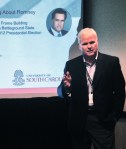Stuart Hall, 1932-2014
The Guardian has more on the death of Stuart Hall, whose work in the 1970s helped create the field of cultural studies.
Research Presentation: Frame Building in a Battleground State in the 2012 Presidential Election
I recently presented research at the AEJMC national conference in Washington, D.C. Dien Anshari co-authored the paper, which used content analysis to study Obama campaign frame building efforts in Ohio during the recent presidential campaign. The paper has been accepted for publication in Journalism and Mass Communications Quarterly. I’ll add a link when JMCQ posts the work online.
A Short-Form Essay for the Columbia Journalism Review
The Columbia Journalism Review is running a feature in which it asks a wide range of people to answer these questions: What is journalism for? And who is a journalist? Here’s the catch: The answers are limited to 100 words (or thereabouts). Here’s what I wrote:
Digital production and networked communication now allow anyone to create content and disseminate it widely. In this environment, we should consider journalism as an approach to content creation. Those who employ the journalistic approach strive to produce content that helps users better understand and navigate their communities. This approach is characterized by rigorous research and verification, the fair presentation of competing ideas, and a commitment to independent inquiry that follows the facts, challenges the facile and engages with complexity and ambiguity. The journalistic approach can be applied to any form of content. And its use is not limited to those who identify as journalists. It is the act of informing and enlightening that defines content as journalism, not the actor who created it.
New Publication: A look at Frame Building in a Battleground State in the 2012 Presidential Election
Journalism and Mass Communications Quarterly has been kind enough to accept my latest research work for publication. Dien Anshari and I made use of Robert M. Entman’s concept of “content bias” to explore the Obama campaign’s frame-building effort in Ohio in late spring and summer of the 2012 race. Our key finding suggests the president’s team managed to increase use of the vulture capitalist frame in Ohio newspaper coverage of Republican Mitt Romney during that time period. More details — and a link — coming soon.
Is It Time to Give Up on CNN? My Take on Coverage of the George Zimmerman Trial
I wrote this essay as a tumblr post, merely as a personal rant. Gawker editor John Cook spotted it there and asked if he could use it on the site. I dislike criticizing my former employer; I have great respect for many people who work there. But I thought the point was worth making, and I’m pleased it got some attention. The next day, NPR’s David Folkenflik gave me an opportunity to express my opinion on the trial’s coverage in a piece he did for All Things Considered.
A Nice Promotional Tweet from a South Carolina Journalist
Current reading: Partisan Journalism and the Rise of the Republican Party in South Carolina, 1959–1962 by @sidbedingfield #sctweets
— coreyhutchins (@CoreyHutchins) March 11, 2013
New Publication: Partisan Journalism and the Rise of the Republican Party in South Carolina, 1959-1962.
U.S. media historians have written extensively about the transition from the partisan journalism of the nineteenth century to the nonpartisan, professionalized news system that has dominated the past century. What has gotten less attention, however, is the difficulty professional journalists have had in reconciling their allegiance to impartial journalism with their occasional desire to engage more deeply in the politics of their communities. I use the story of two South Carolina journalists who helped build the conservative Republican Party in the Deep South as a case study to highlight this tension. You can find the article here in the Spring 2013 edition of Journalism and Mass Communications Quarterly.
USC Journalism Students Cover Democratic National Convention
Our journalism students were all over Charlotte during the Democratic National Convention last week. (The picture above shows Jamie Hicks in the AP skybox. She would later report from the convention floor after first lady Michelle Obama’s speech.)
Dean Charles Bierbauer and I began work late last year on an internship program tied to the convention. Nineteen senior journalism students interned with six news organizations — Associated Press, CNN, National Journal, The Charlotte Observer, Raycom, and Time Warner Cable’s News 14 Carolina. I want to give special thanks to the AP and The Charlotte Observer; both went out of their way to give their interns a substantive experience. As usual, the students rose to the occasion. More pictures and details here.
And now a bit of commentary: I always say internships are valuable because students can get an up-close look at the good — and the bad. They can learn from both. At the convention, they saw lots of great deadline political journalism from six news organizations that had developed smart coverage plans that fit the needs of their audiences. But the students saw some other, unnamed news organizations waste a lot of valuable resources. As a political communications guy, I occasionally find myself defending the news value of political conventions. They are not what they used to be, obviously, but there is some modest value in allowing the modern convention to serve as a curtain-raiser on the Fall campaign. Yet do conventions require the number of journalists who flooded into Charlotte? Hardly. News organizations that are struggling to define themselves in the digital age need to think harder about how to add value for their readers and viewers. Duplicating political convention coverage that is readily available elsewhere is not the way to do that.
In its Search for Big, Buzz-Worthy Analysis, Politico Stumbles
I am fan of Politico.com. I understand and appreciate its near obsessive commitment to speed and breadth and – most of all – buzz. Those are pretty much the price of entry for a political site trying to survive online these days. But let’s face it: Some of Politico’s analytical efforts would benefit from a moment of reflection and a bit of common-sense editing.
Consider these two examples:
First, media reporter Dylan Byers uses the dust-up over Romney’s “birther” joke to make a point about social media and the news cycle. Romney delivered his birth certificate comment at a Michigan rally shortly after noon Friday. Within 21 minutes, Byers tells us, Romney’s words had been reported on twitter, defended by the Romney camp, attacked by the Obama campaign, and debated extensively online. “The whole story – from gaffe to attack to defense – was shorter than a sitcom episode,” he writes.
So far so good. It’s worth documenting the speed with which the story developed. Byers missteps, however, when he overstates the impact.
Social media has shortened the news cycle, he says, and the two campaigns don’t understand what this new reality means. Their communications teams remain in rapid-response mode, when in fact they should slow down.
By delivering their attack immediately, Byers claims, the Obama team ensured the story would play out quickly. By early evening the social media buzz around the birth certificate joke had faded, and therefore Byers contends the story had lost its legs. The Obama campaign had missed an opportunity by moving too fast and allowing the controversy to peak too soon.
Did voters really miss this political story? Not if they caught a Friday evening television newscast. All three broadcast networks topped their political coverage with the birth certificate debate. Scott Pelley, who was in Michigan, made the subject topic A in his interview with Romney. The local newscasts that I saw played the story high as well.
As you might expect, the cable news networks ran wild with the controversy – at least MSNBC and CNN did. And the big websites – the Times, the Post, CNN, NBCNews, and, yes, Politico – pushed the story well into Saturday morning. And yes, even the print newspapers – those vestiges of the ancient 24-hour news cycle – topped their political coverage with the Romney joke debate.
Social media is changing how political communication flows to the public. And in some ways it is shortening the news cycle, just as the arrival of radio, television, cable television and online news did during earlier times. But that doesn’t mean the news cycle stops when the social media “tsunami” wanes a bit. As much as I respect the power of social media, I am willing to bet that more voters — not political junkies, but actual voters — read or heard about the fallout from Romney’s birth certificate comments Friday evening and Saturday morning rather than during the immediate aftermath of his speech.
Even Byers realized his social media thesis had holes in it. Near the bottom of his piece, he notes the recent USC Annenberg/Los Angeles Times study that found most voters still turn to legacy media to get their political news. That might not be true in 2016 or 2020, but it remains so now.
The “21-minute news cycle” is a cool, buzz-worthy concept – but its impact is not as profound as Politico claims, at least not yet.
And that second Politico misstep? At The Monkey Cage, Political scientist David Karol of the University of Maryland takes apart claims about the “new media establishment” rising to power in the Republican Party in the wake of Paul Ryan’s VP selection. It all depends on how you describe “establishment.” Restricting it to party officials only ignores reality. Media heavyweights have played a role in shaping political party decisions throughout U.S. history.
Again, Politico is reaching for a big, buzz-worthy piece of analysis. Karol refutes the simplistic thesis.
.
New Publication: Searching for Bias, Slant, and Frame Selection in Murdoch’s Wall Street Journal
Newspaper Research Journal recently published my article investigating possible news slant in Rupert Murdoch’s Wall Street Journal. (Unfortunately, the piece is out in print only and is not available online yet.) I launched my research project after reading this article by New York Times media columnist David Carr: Tilting to the Right at Murdoch’s Wall Street Journal – NYTimes.com. The empirical data appears to contradict the early anecdotal evidence. But my study is merely a first step in studying Murdoch’s impact on the Journal and is far from definitive. Much more work should be done.

